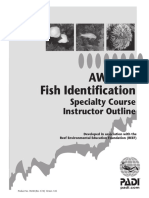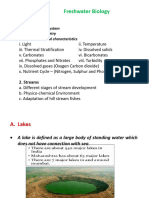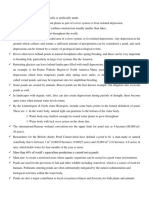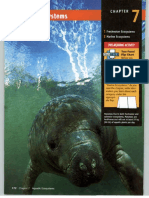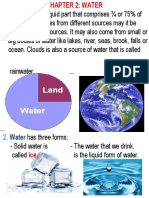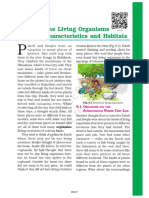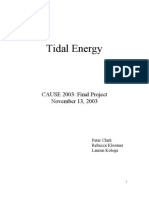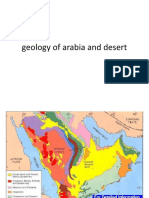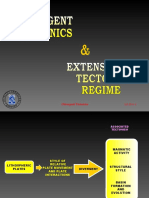Content Outline
Content Outline
Uploaded by
api-6587761460 ratings0% found this document useful (0 votes)
55 views4 pagesThis document provides information about different bodies of water including lakes, rivers, ponds and streams. It describes where each can be found and their key characteristics such as temperature, depth, flow and size. Examples of common plants and animals found in each are also listed. The document concludes by outlining important process skills for scientists studying these ecosystems such as classification, observation, and modeling.
Original Description:
Original Title
content outline
Copyright
© © All Rights Reserved
Available Formats
PDF, TXT or read online from Scribd
Share this document
Did you find this document useful?
Is this content inappropriate?
Report this DocumentThis document provides information about different bodies of water including lakes, rivers, ponds and streams. It describes where each can be found and their key characteristics such as temperature, depth, flow and size. Examples of common plants and animals found in each are also listed. The document concludes by outlining important process skills for scientists studying these ecosystems such as classification, observation, and modeling.
Copyright:
© All Rights Reserved
Available Formats
Download as PDF, TXT or read online from Scribd
Download as pdf or txt
0 ratings0% found this document useful (0 votes)
55 views4 pagesContent Outline
Content Outline
Uploaded by
api-658776146This document provides information about different bodies of water including lakes, rivers, ponds and streams. It describes where each can be found and their key characteristics such as temperature, depth, flow and size. Examples of common plants and animals found in each are also listed. The document concludes by outlining important process skills for scientists studying these ecosystems such as classification, observation, and modeling.
Copyright:
© All Rights Reserved
Available Formats
Download as PDF, TXT or read online from Scribd
Download as pdf or txt
You are on page 1of 4
Content Outline
1. Characteristics of Lakes, Rivers, Ponds, and Streams
a. Lakes
i. Where we find them: Lakes are found on every continent and in every
environment. There can be lakes in mountain ranges, deserts, plains and
near seashores.
ii. Temperature/ Characteristics: Lakes can be formed when soluble rocks
are dissolved by water running through the area. This causes a depression
in the ground and water starts to lay there. Temperatures vary greatly
because they can be found in all different parts of the world.
b. Ponds
i. Where we find them: Ponds can be found in gardens, farmland, in woods,
and overall in most places where water can start to form a depression in
the ground.
ii. Characteristics/Temp: The temperature of the water in a pond is the same
from top to bottom. The temperature of the air also affects the water’s
temperature. Ice can form on the tops and bottoms of ponds in very cold
climates. Ponds are smaller and shallower than a lake. Most ponds are
less than six or seven feet deep. Since ponds are shallower most ponds
have plants growing on the bottom from one side of the pond to the
other.
c. Streams
i. Where found: Streams are small bodies of water that can be found
everywhere—they get their start in the headwaters, which may be from
the melting of ice on mountain tops. Many streams that are flowing along
the same general direction meet and combine to form a river.
ii. Characteristics: Streams are usually relatively shallow and, therefore,
have a large surface compared to their depth.The characteristics of a
stream change during the journey from the source to the mouth. The
temperature is cooler at the source than it is at the mouth. The water is
also clearer, has higher oxygen levels, and freshwater fish such as trout
and heterotrophs can be found there. Lots of dissolved oxygen
d. Rivers
i. Where found: Rivers can be found everywhere. Rivers originate from the
meeting of many streams. Rivers are flowing water bodies that have
downhill water flow and usually contain huge quantities of water. Rivers
are the main source of seas and oceans and all rivers ultimately flow into
the sea.
ii. Characteristics: Larger than streams. Rivers carry and distribute important
salts and nutrients to support plant and animal life. Can be deep and
wide. Temperature of water can vary from top to bottom based on the
depth. Rivers carry pebbles and sand.
2. Lakes- A large body of water completely surrounded by land. Lakes are usually larger and
deeper than ponds. Lakes can be used for recreational activities such as fishing, boating,
and swimming.
a. Plants
i. Fragrant Water Lily
ii. Yellow Flag Iris
iii. Blue Green Algae
iv. Submerged Coontail
b. Animals
i. Water Snakes
ii. Ducks
iii. Fish
iv. Painted turtles
3. Ponds: are small areas of still, fresh water. They are different from a river or a
stream because they do not have moving water and they differ from lakes
because they have a smaller area. Some ponds are formed naturally, filled either
by an underwater spring or by rainwater; other ponds are artificially (man) made.
a. Plants
i. Water lettuce
ii. Mosaic
iii. Waterlilies
iv. Algae
b. Animals
i. Turtles
ii. Fish
iii. Ducks
iv. Frogs
4. Streams: A stream is a body of water that flows on Earth’s surface. The word stream is
often used interchangeably with river, though rivers usually describe larger streams.
Streams provide many benefits to humans. Besides providing drinking water and
irrigation for crops, streams wash away waste and can provide electricity through
hydropower. People often use streams recreationally for activities such as swimming,
fishing, and boating. Streams also provide important habitat for wildlife.
a. Plants
i. Water lettuce
ii. Cattails
iii. water lily
iv. algae
b. Animals
i. fish
ii. turtles
iii. Frogs
iv. Crabs
5. Rivers: A river is a natural flowing watercourse, usually freshwater, flowing towards an
ocean, sea, lake or another river.
a. Animals
i. Fish
ii. Beavers
iii. Frogs
iv. Otters
b. Plants
i. Algae
ii. Hydrilla
iii. Cattail
iv. Duckweed
6. Process Skills
a. Classification: Scientists use classification to help them understand how living
things are related to each other and to organize living things into groups.
i. Determining the different characteristics of each body of water
ii. Sorting plants and animals according to the bodies of water
iii. Select correct animals and plants to go into models based on their
characteristics and adaptations needed to survive
b. Observation: Scientists use observations to collect and record data, which
enables them to construct and test hypotheses and theories
i. Recording observations from different resources (videos, books,
specimens, etc) and documenting specific characteristics and/or
information.
c. Modeling: Scientists use models to explain and predict the behavior of real
objects or systems
i. Using different manipulatives and material to create a representation of
different water bodies and how they are formed.
ii. Use different materials to create an accurate representation of a water
body with animals that have characteristics to help them live in that
environment
You might also like
- Aware Fishid Sig LPDocument38 pagesAware Fishid Sig LPStephanie StephanieNo ratings yet
- GEOGRAPHY IGCSE Riassunti PP 4-46, 52-151Document28 pagesGEOGRAPHY IGCSE Riassunti PP 4-46, 52-151tommaso100% (1)
- Science and EarthDocument2 pagesScience and EarthAspeya IsahNo ratings yet
- Report in Science Group 2Document16 pagesReport in Science Group 2Angelie AnilloNo ratings yet
- Lesson Exemplar Plan in Grade 5 Science Elementary: of - HTML?M 1Document7 pagesLesson Exemplar Plan in Grade 5 Science Elementary: of - HTML?M 1Patria Hence GabuyaNo ratings yet
- Peyton's Freshwater Lakes BrochureDocument2 pagesPeyton's Freshwater Lakes BrochureCharles Ippolito100% (1)
- CLASS 6TH The Living Organisms and Their SurroundingsDocument22 pagesCLASS 6TH The Living Organisms and Their SurroundingsSaurabh GuptaNo ratings yet
- Susie's Freshwater River Travel BrochureDocument2 pagesSusie's Freshwater River Travel BrochureCharles IppolitoNo ratings yet
- WATERDocument20 pagesWATERchristine alfaroNo ratings yet
- Aquatic EcosystemsDocument5 pagesAquatic Ecosystemsapi-236697820No ratings yet
- Schience and EarthDocument2 pagesSchience and EarthAspeya IsahNo ratings yet
- My LimnologyDocument49 pagesMy LimnologyLaiba HassanNo ratings yet
- HabitatDocument4 pagesHabitatEman Fatima GulnawazNo ratings yet
- My A1 PresentationDocument18 pagesMy A1 PresentationZainab YusufNo ratings yet
- Pond EcosystemDocument5 pagesPond EcosystemSiva Prasad100% (2)
- Aquatic HabitatDocument4 pagesAquatic HabitatRuno OmughelliNo ratings yet
- Freshwater BiologyDocument60 pagesFreshwater BiologyROHAN SHARMANo ratings yet
- Q4 - LAS - Science4 - Week2 Version 1Document13 pagesQ4 - LAS - Science4 - Week2 Version 1Nick ZhegyleNo ratings yet
- 03 Aquatic Habitat & RehabDocument18 pages03 Aquatic Habitat & RehabEugene SaldivarNo ratings yet
- FEG-211 (1) Lacture 1 - Ponds & ClassificationDocument7 pagesFEG-211 (1) Lacture 1 - Ponds & ClassificationLA TSHERING LEPCHANo ratings yet
- Chapter 9Document6 pagesChapter 9Abhinaba PaulNo ratings yet
- The Worlds WaterDocument15 pagesThe Worlds WaterHannah Menchie AbulonNo ratings yet
- JSS2 Basic Science 1st TermDocument35 pagesJSS2 Basic Science 1st TermAliyu Lawal KofaNo ratings yet
- Natural Water BodiesDocument1 pageNatural Water BodiesSaadiaNo ratings yet
- C06 - Science - 11. Habitats of OrganismsDocument4 pagesC06 - Science - 11. Habitats of OrganismsLokesh AgarwallaNo ratings yet
- Aquatic BiomesDocument4 pagesAquatic BiomesJenny ReynosaNo ratings yet
- Pond EcosystemDocument24 pagesPond EcosystemshobhitNo ratings yet
- River As An EcosystemDocument7 pagesRiver As An EcosystemgulyNo ratings yet
- Enviro Science CHPT 07Document22 pagesEnviro Science CHPT 07Eduardo HigaredaNo ratings yet
- Science 4 (Lesson 27)Document9 pagesScience 4 (Lesson 27)Katrina Fulong GaviñoNo ratings yet
- Uses of Water From The Different SourcesDocument81 pagesUses of Water From The Different SourcesAljoe Vallejos AsuncionNo ratings yet
- TARPAPELDocument22 pagesTARPAPELDhendina Endeno-EvaNo ratings yet
- SLE Lesson 3 - Bodies of Water in Your CommunityDocument4 pagesSLE Lesson 3 - Bodies of Water in Your CommunityKat Causaren Landrito93% (14)
- G5Q2 Week 7 ScienceDocument56 pagesG5Q2 Week 7 ScienceArlene CabalagNo ratings yet
- Different Water BodiesDocument10 pagesDifferent Water BodiesmanishaNo ratings yet
- Geo-Studies chp-1 (Water)Document9 pagesGeo-Studies chp-1 (Water)habiba buttNo ratings yet
- Aquatic Ecosystems Study GuideDocument7 pagesAquatic Ecosystems Study Guideapi-239136335No ratings yet
- Water The Medium of LifeDocument29 pagesWater The Medium of LifedosiNo ratings yet
- DLL-COT-SCIENCE5-Week 6Document5 pagesDLL-COT-SCIENCE5-Week 6Rhona Liza Canobas100% (2)
- AcknowledgementDocument7 pagesAcknowledgementshaankk100% (1)
- The Worlds WaterDocument15 pagesThe Worlds WaterTejaswiniNo ratings yet
- WaterDocument2 pagesWaterLS - 10KG 955129 John Fraser SSNo ratings yet
- 1ST Term S2 BiologyDocument38 pages1ST Term S2 BiologyBarbaraNo ratings yet
- The Living Organisms - Characteristics and Habitats: 9.1 O S W T LDocument16 pagesThe Living Organisms - Characteristics and Habitats: 9.1 O S W T LGames ZoneNo ratings yet
- MPRA Paper 43810Document7 pagesMPRA Paper 43810Koushik MandalNo ratings yet
- CHAPTER17Document18 pagesCHAPTER17Ankit JainNo ratings yet
- Module 2 Characteristics of BiosphereDocument8 pagesModule 2 Characteristics of BiosphereMarvhieNo ratings yet
- Freshwater EnvironmentsDocument18 pagesFreshwater EnvironmentsRouba ZreinNo ratings yet
- Rivers and Streams BiomeDocument13 pagesRivers and Streams Biomeapi-276114750No ratings yet
- PeirceDocument7 pagesPeirceapi-347445923No ratings yet
- Ocean Habitats Note-Taking Worksheet: Name: PeriodDocument3 pagesOcean Habitats Note-Taking Worksheet: Name: Periodapi-317830512No ratings yet
- Aquatic Ecosystem: I. LakesDocument6 pagesAquatic Ecosystem: I. LakesJohn Paul Espiña CandoNo ratings yet
- Freshwater and WetlandsDocument84 pagesFreshwater and WetlandsTito, Stephen Gabriel, A.No ratings yet
- AquaticDocument34 pagesAquaticCaroline ConsolacionNo ratings yet
- Aquatic Ecosystem: Tricia Mae C. Atienza SoctaresDocument15 pagesAquatic Ecosystem: Tricia Mae C. Atienza SoctaresTricia Mae Comia Atienza100% (1)
- Earth Subsystem: HydrosphereDocument23 pagesEarth Subsystem: HydrosphereRhiza Mae LaxNo ratings yet
- Oh The Places Youll Go LessonDocument4 pagesOh The Places Youll Go Lessonapi-658776146No ratings yet
- Topic 14 l1Document2 pagesTopic 14 l1api-658776146No ratings yet
- Small Group Clever Rabbit 1Document2 pagesSmall Group Clever Rabbit 1api-658776146No ratings yet
- Cell Phone Scoot: Time To The Nearest MinuteDocument12 pagesCell Phone Scoot: Time To The Nearest Minuteapi-658776146No ratings yet
- Philosophy of EducationDocument1 pagePhilosophy of Educationapi-658776146No ratings yet
- Assessment DetailsDocument3 pagesAssessment Detailsapi-658776146No ratings yet
- Finger Printing 2022Document2 pagesFinger Printing 2022api-658776146No ratings yet
- TOEFL ReadingDocument4 pagesTOEFL ReadingJenn LazoNo ratings yet
- Unit 2 Lesson 1Document17 pagesUnit 2 Lesson 1mohammedNo ratings yet
- Tidal EnergyDocument46 pagesTidal EnergyAbhishek Banavali100% (1)
- BENTHOS (Benthic Animals)Document7 pagesBENTHOS (Benthic Animals)Christine Israel AbrahamNo ratings yet
- Ce-12101: Environment and Climate Change Course Instructor: Dr. Pramod SoniDocument16 pagesCe-12101: Environment and Climate Change Course Instructor: Dr. Pramod Sonipramodsoni41No ratings yet
- Geology of Arabia and DesertDocument34 pagesGeology of Arabia and DesertDakara CiptadesainNo ratings yet
- Insang Udang B 10Document1 pageInsang Udang B 10agungNo ratings yet
- CompleteBook CompressPdf1Document21 pagesCompleteBook CompressPdf1undisclosedlocation666No ratings yet
- The Best Time of Year To Visit Phi Phi Don in Thailand: Other Facts From Our Historical Climate DataDocument1 pageThe Best Time of Year To Visit Phi Phi Don in Thailand: Other Facts From Our Historical Climate DataHetvi PatelNo ratings yet
- Chapter 2: Threats To The Marine Environment: Pollution and Physical DamageDocument15 pagesChapter 2: Threats To The Marine Environment: Pollution and Physical DamagePablo E Bravo SNo ratings yet
- Biomes and BiosdiversityDocument46 pagesBiomes and Biosdiversity게이밍미라클No ratings yet
- Academic Reading 1 - Passage 1: The Coral Reefs of Agatti IslandDocument4 pagesAcademic Reading 1 - Passage 1: The Coral Reefs of Agatti IslandPablo VelasquezNo ratings yet
- Chapter 2 RRLDocument13 pagesChapter 2 RRLNoreen Guiyab Tannagan100% (1)
- GeoTektonik - DivergenDocument45 pagesGeoTektonik - DivergenbeyNo ratings yet
- British Weather and ClimateDocument1 pageBritish Weather and ClimateОлінька СтецюкNo ratings yet
- IA ESS First DraftDocument3 pagesIA ESS First DraftmartinaNo ratings yet
- Beach & Ocean Titles Ideas For Scrapbook Layouts and CardsDocument23 pagesBeach & Ocean Titles Ideas For Scrapbook Layouts and CardsOlivia RamosNo ratings yet
- Detailed Lesson Plan in Science ViDocument6 pagesDetailed Lesson Plan in Science ViJustin Ace MallorcaNo ratings yet
- Lecture Slides Seafloor Spreading ADocument25 pagesLecture Slides Seafloor Spreading ABLISELDA BICALDONo ratings yet
- 12 EngDocument6 pages12 EngMohammed AmmaarNo ratings yet
- Deterrent Techniques and Bird Dispersal Approach FDocument89 pagesDeterrent Techniques and Bird Dispersal Approach FAlma ChávezNo ratings yet
- Resplandy Et Al-2018-NatureDocument16 pagesResplandy Et Al-2018-NatureKyle CopasNo ratings yet
- Outdoor Swimming Safety Brochure 20240412 163330 0000Document2 pagesOutdoor Swimming Safety Brochure 20240412 163330 0000harvey gail smithNo ratings yet
- The Mermaid of Kona, Hawaii Answer KeyDocument8 pagesThe Mermaid of Kona, Hawaii Answer Keyli zhangNo ratings yet
- KrakenDocument134 pagesKrakenmazza_roNo ratings yet
- Science 10 First Quarter ReviewerDocument6 pagesScience 10 First Quarter ReviewerPlayer 456100% (1)
- The Mesozoic Era Age of DinosaursDocument196 pagesThe Mesozoic Era Age of DinosaursSANDRA BALLESTEROSNo ratings yet
- Blue Economy CourseDocument2 pagesBlue Economy CourseKenneth FrancisNo ratings yet
